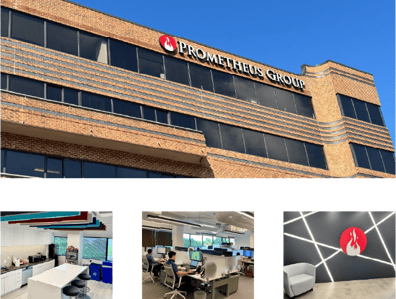While maintenance organizations differ depending on the industry, size, region, and overall organizational structure, there are certain things that all maintenance organizations should be doing no matter the aforementioned variables.
1. Prioritizing Safety
Safety must always be a focus of all maintenance organizations.
It is the duty and responsibility of the company to ensure that all employees’ safety is of the top concern.
And while it is difficult to completely eliminate hazards within the workplace, there are measures that can be taken to reduce situations that may pose a risk to the worker and to the environment.
One way that maintenance organizations can minimize risk to their workers is to eliminate (or greatly reduce) any unplanned or emergency work.
Through the elimination of emergency work, you can better ensure that the asset/machine that is receiving maintenance is offline and that all the appropriate tools and resources (people) needed are available when the maintenance is planned to be performed.
Proper planning and scheduling play an important role in the elimination of emergency work.
By having sufficient preventive maintenance processes in place, you help reduce the likelihood of unplanned downtime.
Many maintenance organizations have already started to shift from reactive to preventive maintenance, with many more heading towards predictive maintenance in the hopes of eliminating unplanned downtime and emergency work altogether.
2. Capturing and Analyzing Data
“Without data, you’re just another person with an opinion.” – Deming.
We are living in the data age. The sheer volume of data that is being collected is almost incomprehensible.
The majority of organizations are hiring data scientists and data analysts to sift through all of the millions of data points that are being collected in order to make sense of it all and spot trends for optimization purposes.
It’s no secret that data is valuable but understanding how to analyze it is even more valuable.
As mentioned above, many maintenance organizations are shifting from reactive to preventive to predictive maintenance.
In order to become a truly predictive maintenance organization, it is imperative that data is not only being collected but being used to better understand a company’s asset performance as well as when maintenance should be performed to prolong the life of the asset. All while keeping safety and production top of mind.
Not all assets are created equal!
Meaning, assets must be ranked by their criticality in order to ensure that the most critical assets are kept running so that production is optimized.
Assessing the criticality of assets is something that should be done very early in the overall maintenance process. To read more about asset criticality, you can access our Asset Criticality White Paper here.
3. Managing and Controlling Costs
Controlling costs is a major concern for all maintenance organizations.
Maintenance has often been seen as a cost center and so controlling those costs becomes pretty important in terms of a company’s overall bottom-line.
Gaining control of maintenance costs is a team effort that requires effective tools and continuous process improvement.
It requires the visibility afforded by aligning analytics, budgeting, scheduling, warranty, and mobility tools that operate together as a natural extension of the corporate financials and asset management systems (ERP/EAM), greatly simplifying cost management.
There are many different areas and practices in which maintenance costs can be controlled, such as:
- Recognizing how maintenance influences performance and profitability
- Properly prioritizing maintenance work
- Taking actions based on analytics
- Applying optimal budgeting strategies
- Ensuring effective planning and scheduling
- Ramping up warranty practices
- Incorporating mobility solutions
- Employing the right tools and technologies.
4. Optimization [of Maintenance Processes]
Optimization is a buzz word that is thrown around all too often. But, the actual process of optimization is an important practice for maintenance organizations looking to maximize equipment uptime and generate as much output as possible from their assets.
In order to truly optimize the maintenance process, you must first have a process in place.
Maintenance is more than just fixing assets. Maintenance comprises many different components such as; identifying what work needs to be completed, the planning and scheduling of that work, the execution and completion of the work, and ultimately, the analysis of all of those steps for continued improvement.
The below graphic identifies the work management process, which is a continuous loop that occurs within maintenance organizations around the world.

The process itself does not seem overly complex but in order to optimize the process, there must be strategies and tools put in place to ensure that no part of the process is being missed and that errors are minimized along the way.
To successfully optimize the maintenance process, there must be a strategy put in place.
5. Strategy Definition and Advancement
Far too often, processes are put in place to address a single pain point without factoring in how that may affect other areas of business operations. Furthermore, once a process has been changed to address a pain point, it is often forgotten or deemed – fixed.
For example, some maintenance organizations will identify the need for improved planning and scheduling processes and simply change their process or add a tool to help with planning and scheduling without fully understanding why their planning and scheduling is failing to begin with. Once that process is changed or a tool gets added, the problem is seen as “fixed” and doesn’t get looked at again until years down the road.
It is important to understand why the planning and scheduling process is failing – is it because the work is not being identified accurately or in a timely manner? Could it be that the work is not being completed as it should be or recorded properly?
There are so many variables that can affect the maintenance process and so it is important to have a strategy that can address the entire maintenance process rather than just one part of it.
Recently, a shift has been taking place at some of the biggest maintenance organizations around the world and that shift is creating a need for maintenance centers of excellence or continuous improvement centers.
These centers are tasked with continually looking at the overall process in order to update old processes and outdated systems and to provide updated training where needed. They are also tasked at looking at all the available options to improve or optimize their maintenance process – whether that be by improving safety, capturing and analyzing data, managing and controlling maintenance costs, or optimizing the overall maintenance processes.
No two maintenance organizations will operate the same, but the above-listed items are things that every maintenance organization should be doing.
To do so often requires help. Help in the form of training for current employees. Help in the form of maintenance leaders in their respective field. And help in the form of new technologies to help bind everything together.
Prometheus Group has developed a suite of asset management software that aims to do just that. To learn more about our The Prometheus Platform, you can visit our platform page here.
If you would like to talk to a member of our team to learn how Prometheus can help you, contact us here.



